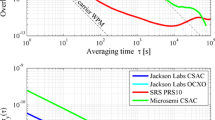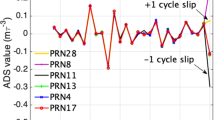Abstract
In global navigation satellite systems (GNSS) navigation the receiver and satellite clocks play a key role. The receivers are usually equipped with inaccurate quartz clocks, which experiment large drift relative to system time and consequently offset growing very fast; receiver manufactures bound the magnitude of the receiver clock offset to prevent it becomes too large and the actual bounding procedures vary from one manufacturer to another. The most common approach consists of introducing discrete jumps when the offset exceeds a threshold (usually 1 ms). This method is common in low-cost GNSS receivers and influences several applications as differential positioning, cycle-slip detection, precise point positioning technique, absolute positioning with Kalman filter. In this work some techniques to detect and account for millisecond clock jump, suitable for code positioning of a single receiver with Kalman filter, are proposed. Two deterministic algorithms to detect receiver clock jumps are shown: in measurement and parameter domain. The technique in measurement domain uses current pseudorange measurements compared with pseudorange and Doppler measurements at previous epoch; the technique in parameter domain compares current and previous least squares estimations of receiver clock bias, considering the clock drift. Two different approaches are described to account for the clock jumps, once detected, a deterministic one, consisting of fixing the pseudorange discontinuities, and a statistic one, consisting of suitably varying the Kalman filter settings. A static GNSS data set is processed with and without the proposed algorithms to demonstrate their efficiency.





Similar content being viewed by others
References
Hoffmann-Wellenhof, B., Lichtenegger, H., & Collins, J. (1992). Global positioning system: Theory and practice. Wien: Springer.
Kaplan, E. D., & Hegarty, J. (2006). Understanding GPS: Principles and applications (2nd ed.). London: Artech House.
Angrisano, A., Gaglione, S., Gioia, C., Borio, D., & Fortuny-Guasch, J. (2013). Testing the test satellites: The Galileo IOV measurement accuracy. In International conference on localization and GNSS, ICL-GNSS 2013.
Angrisano, A., Gaglione, S., & Gioia, C. (2013). Performance assessment of GPS/GLONASS single point positioning in an urban environment. Acta Geodaetica et Geophysica, 48(2), 149–161.
Petovello, M. (2011). GNSS solutions: Clock offsets in GNSS receivers. Inside GNSS 23–25.
Kim, H. S., & Lee, H. K. (2012). Elimination of clock jump effects in low-quality differential GPS measurements. Journal of Electrical Engineering & Technology, 7(4), 626–635.
Kim, H. S., & Lee H. K. (2009). Compensation of time alignment error in heterogeneous GPS receivers. In Proceedings of the 13th IAIN world congress, 27–30 Oct, Stockholm, Sweden.
Kim, D., & Langley, R. B. (2001). Instantaneous real-time cycle-slip correction of dual-frequency GPS data. In Proceedings of the international symposium on kinematic systems in geodesy, geomatics and navigation, Banff, Alberta, Canada, 5–8 June 2001, pp. 255–264.
Kim, D., & Langley, R. B. (2002). Instantaneous real time cycle-slip correction for quality control of GPS carrier-phase measurements. Journal Of the Institute of Navigation, 49(4), 205–222.
Guo, F., & Zhang, X. H. (2012). Real-time clock jump detection and repair for precise point positioning. In Proceedings of the ION GNSS 2012 (pp. 17–21). Nashville, USA.
Guo, F., & Zhang, X. (2013). Real-time clock jump compensation for precise point positioning. GPS Solutions. doi:10.1007/s10291-012-0307-3.
Lonchay, M., Bidaine, B., & Warnant, R. (2011). An efficient dual and triple frequency preprocessing method for GALILEO and GPS signals. In Proceedings of the 3rd international colloquium scientific and fundamentals aspects of the GALILEO programme, Copenhagen, Denmark, 31 Augs–2 Sept.
Bar-shalom, Y., Li, X., & Kirubarajan, T. (2001). Estimation with applications to tracking and navigation. New York: Willey.
Kalman, R. E. (1960). A new approach to linear filtering and prediction problems. Trans. ASME J. Basic Engr. pp. 35–45.
Parkinson, B., & Spilker, J. J. (1996). Global positioning system: Theory and applications (Vol. 1–2). Washington, DC: American Institute of Aeronautics and Astronautics.
Angrisano, A., Gaglione, S., & Gioia (2012). RAIM algorithms for aided GNSS in urban scenario. In Proceedings of the ubiquitous positioning indoor navigation and location based service, Helsinki, Finland, October 2012.
Author information
Authors and Affiliations
Corresponding author
Rights and permissions
About this article
Cite this article
Angrisano, A., Gaglione, S. & Troisi, S. Real-Time Receiver Clock Jump Detection for Code Absolute Positioning with Kalman Filter. Wireless Pers Commun 79, 211–221 (2014). https://doi.org/10.1007/s11277-014-1849-1
Published:
Issue Date:
DOI: https://doi.org/10.1007/s11277-014-1849-1




